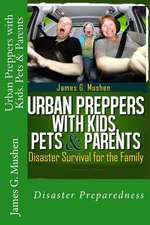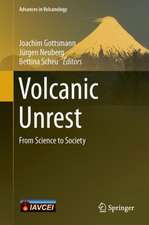Extreme Weather, Health, and Communities: Interdisciplinary Engagement Strategies: Extreme Weather and Society
Editat de Sheila Lakshmi Steinberg, William A. Spriggen Limba Engleză Paperback – 22 apr 2018
| Toate formatele și edițiile | Preț | Express |
|---|---|---|
| Paperback (1) | 646.11 lei 6-8 săpt. | |
| Springer International Publishing – 22 apr 2018 | 646.11 lei 6-8 săpt. | |
| Hardback (1) | 652.49 lei 6-8 săpt. | |
| Springer International Publishing – 29 apr 2016 | 652.49 lei 6-8 săpt. |
Preț: 646.11 lei
Preț vechi: 760.13 lei
-15% Nou
Puncte Express: 969
Preț estimativ în valută:
123.64€ • 127.74$ • 102.85£
123.64€ • 127.74$ • 102.85£
Carte tipărită la comandă
Livrare economică 19 martie-02 aprilie
Preluare comenzi: 021 569.72.76
Specificații
ISBN-13: 9783319808543
ISBN-10: 3319808540
Ilustrații: XXI, 388 p. 42 illus., 39 illus. in color.
Dimensiuni: 155 x 235 mm
Greutate: 0.58 kg
Ediția:Softcover reprint of the original 1st ed. 2016
Editura: Springer International Publishing
Colecția Springer
Seria Extreme Weather and Society
Locul publicării:Cham, Switzerland
ISBN-10: 3319808540
Ilustrații: XXI, 388 p. 42 illus., 39 illus. in color.
Dimensiuni: 155 x 235 mm
Greutate: 0.58 kg
Ediția:Softcover reprint of the original 1st ed. 2016
Editura: Springer International Publishing
Colecția Springer
Seria Extreme Weather and Society
Locul publicării:Cham, Switzerland
Cuprins
Introduction.- Superstorm Sandy: a Game Changer?.- Extreme Weather: Politicsand Public Communication.- Dust Storms, Human Health and a Global Early WarningSystem.- Interdisciplinary Engagement of People and Place around Extreme Weather.- Engaging Communitiesto Assess the Health Effects of Extreme Weather in the Arctic.- Refining theProcess of Science Support for Communities around Extreme Weather Events andClimate Impacts.- Reducing Vulnerability to Extreme Heat throughInterdisciplinary Research and Stakeholder Engagement.- Sociospatial Modelingfor climate-based emergencies: Extreme Heat Vulnerability.- Drought and Health in the Context of Public Engagement.-Extreme Weather:Mental Health Challenges and Community Response Strategies.- ExtremeWinter: Weaving Weather and Climate into a Narrative through Laura IngallsWilder.- The Air We Breathe: How Extreme Weather Conditions Harm Us.- HumanResponse to and Consequences of the May 22, 2011, Joplin Tornado.- Approachesfor Building Community Resilienceto Extreme Heat.
Notă biografică
Dr. Sheila Lakshmi Steinberg is aProfessor of Social and Environmental Sciences at Brandman University-ChapmanUniversity System, Irvine, CA. The themethroughout her research is examining people and their relationship to space andplace.Steinberg’s research interests includeenvironmental sociology, research methods, social inequality, community,geospatial research (GIS) and policy. Sheila has always been interested in theweather and climate from living in so many different parts of the U.S.Recently, she co-authored a book entitled GIS Research Methods: Incorporating Spatial Perspectives for Esri Pressand has also co-authored a chapter on this topic entitled"Geospatial Analysis Technology and Social Science Research" in the Handbookof Emergent Technologies, Sharlene Hesse-Biber, Editor, Oxford UniversityPress 2011. In 2006, she co-authored a book for Sage Publicationsentitled, GIS for the Social Sciences: Investigating Space and Place. In2013, she joined Brandman University where she now teaches courses related tosocial and environmental sciences.
William A. Sprigg, Ph.D., Yale University is ResearchProfessor Emeritus, University of Arizona, the current and founding director ofthe World Meteorological Organization’s Pan-America Center for airborne dustforecasting in Barbados, and research associate of the Public Health Institutein California. He is a member of the American Meteorological Society’s Board onEnvironment & Health, the Chinese Academy of Sciences Committee for DigitalEarth Observations, and the Serbian Program of Basic Research, EnvironmentalProtection and Climate Change. Former positions includeDistinguished Professor at California’s Chapman University, Director, U.S.National Research Council Board on Atmospheric Science and Climate, head of theU.S. National Climate Program Office, and architect of the U.S. ClimateProgram. He participated in the first Intergovernmental Panel on ClimateChange. Authoring a number of technical publications on climate and, mostrecently, on his current research interests, airborne dust and human health,Dr. Sprigg continues his interests in interdisciplinary research and sciencepolicy.
William A. Sprigg, Ph.D., Yale University is ResearchProfessor Emeritus, University of Arizona, the current and founding director ofthe World Meteorological Organization’s Pan-America Center for airborne dustforecasting in Barbados, and research associate of the Public Health Institutein California. He is a member of the American Meteorological Society’s Board onEnvironment & Health, the Chinese Academy of Sciences Committee for DigitalEarth Observations, and the Serbian Program of Basic Research, EnvironmentalProtection and Climate Change. Former positions includeDistinguished Professor at California’s Chapman University, Director, U.S.National Research Council Board on Atmospheric Science and Climate, head of theU.S. National Climate Program Office, and architect of the U.S. ClimateProgram. He participated in the first Intergovernmental Panel on ClimateChange. Authoring a number of technical publications on climate and, mostrecently, on his current research interests, airborne dust and human health,Dr. Sprigg continues his interests in interdisciplinary research and sciencepolicy.
Textul de pe ultima copertă
This volume presents a unique interdisciplinary approach, drawing on expertise in both the natural and social sciences. A primary goal is to present a scientific and socially integrated perspective on place-based community engagement, extreme weather, and health. Each year extreme weather is leading to natural disasters around the world and exerting huge social and health costs. The International Monetary Fund (2012) estimates that since 2010, 700 worldwide natural disasters have affected more than 450 million people around the globe. The best coping strategy for extreme weather and environmental change is a strong offense. Communities armed with a spatial understanding of their resources, risks, strengths, weaknesses, community capabilities, and social networks will have the best chance of reducing losses and achieving a better outcome when extreme weather and disaster strikes.
Caracteristici
Unique, interdisciplinary approach to social dimensions of meteorology, health and environment Addresses the need to better understand connections between weather, changing environments and health Presents a place-based spatial focus Highlights case studies of successful weather/health/environment engagement strategies Includes supplementary material: sn.pub/extras






















